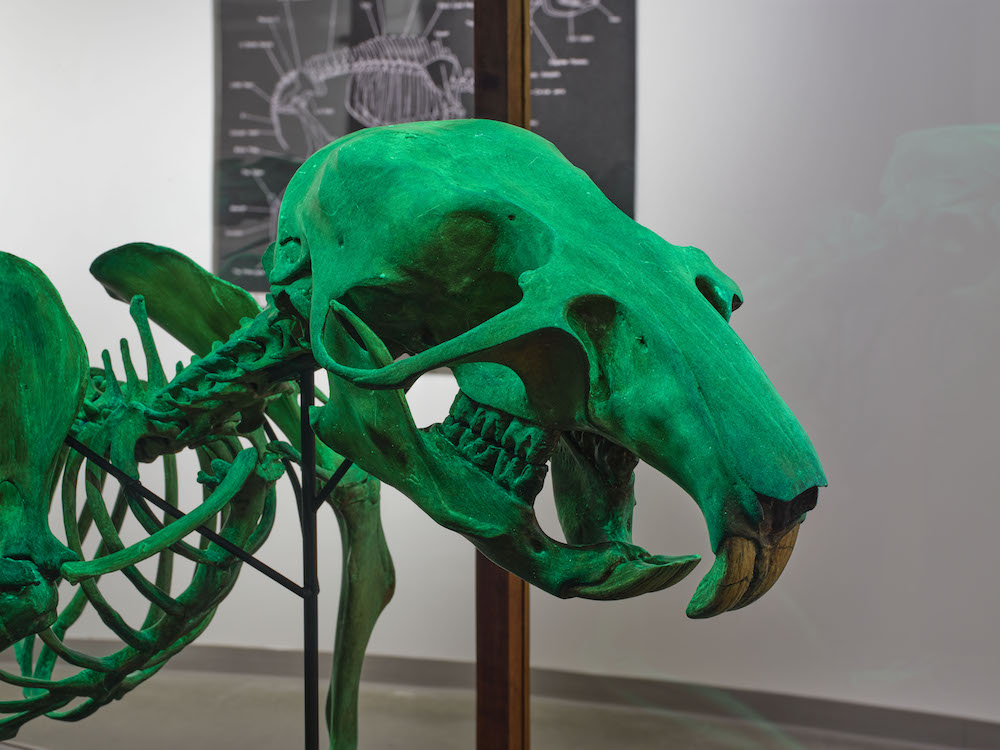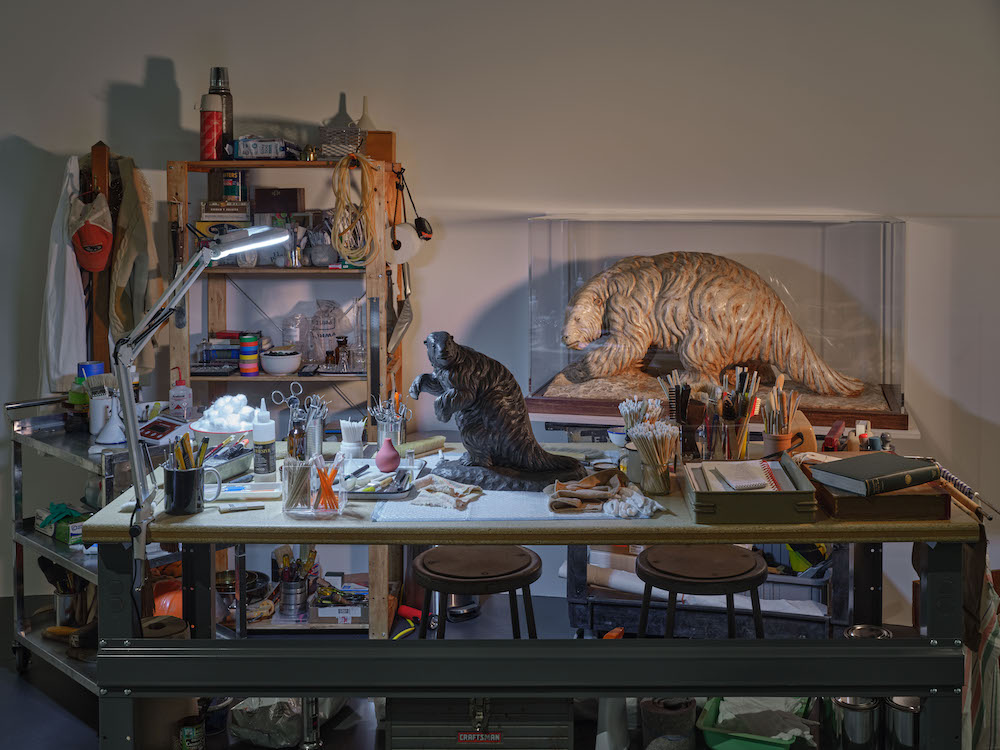As an urban kid growing up on Manhattan’s Upper West Side, I adored the American Museum of Natural History. The low-lit museum seemed like a palace of wonders to me. In its inner chambers the glowing dioramas of exotic animals in their native habitats appeared like scenarios from a dream, at once factual, scientific and a bit surreal. So, when I first discovered Mark Dion’s brilliant, dreamlike natural history–oriented work in the mid-1990s, I was instantly enthralled. Displaying the offices of unlikely nature-oriented civic agencies or effusively baffling cabinets of curiosities, Dion’s works seemed fantastical, yet also rigorously researched, striking a tone at once critical and playful. Beyond a mere fascination with nature, his works focused on interrogating the knowledge systems we create to understand it.
Over the past 30 years Dion has become known for his extended engagement with natural history museums, their collections, and their narratives, often in tandem with excavating forays into historically resonant ecological sites. He’s had exhibitions at such prominent venues as the Tate Gallery in London (1999), MoMA in New York (2004), Olympic Sculpture Park in Seattle (2006), the ICA in Boston (2017) and the Amon Carter Museum of American Art in Fort Worth (2020). For the latter show, he traversed West Texas for over two years, collecting specimens in the footsteps of Audubon and Frederick Law Olmsted.
Dion has now set his focus on one of the world’s most metaphorically loaded natural wonders: LA’s own La Brea Tar Pits, and the nearby, ever-popular George C. Page Museum. The resulting exhibition, eight years in the making, is titled “Mark Dion: Excavations.” Created as part of the Getty’s “PST: Art & Science Collide” initiative, it turns an affectionate spotlight onto the museum itself, making full use of the artist’s ability to deconstruct and riff on the tactics of natural history museum display. While its tone might initially seem as dry as one of the numerous extinct specimens on view, Dion’s own attitude is less reserved. “I’ve always had a love for this place,” he says, standing amidst the resurrected panoply of prehistoric animals and skeletons.
Dion’s first visit to the Tar Pits came in 1986, after driving down from Expo ’86 in Vancouver with a friend purely in order to see them. He kept returning over the decades, drawn by a fascination with “the idea of tar and death, extinction related to fossil fuel consumption and petroleum culture.” He’s since employed tar repeatedly in his work, embracing its symbolism “as a material which snuffs out life, which suffocates and pollutes.” In 2016, he was invited to link up with Weiss/Manfredi, the architectural firm that won a competitive commission to redesign the 1977 museum and park over two other, big-name starchitect teams. Dion was central in ensuring that the iconic mastodon family preserved in tar was retained, after the other teams had wanted to eliminate it.

Mark Dion at the La Brea Tar Pits, 2024. Courtesy NHMLAC, Mark Dion, and Tanya Bonakdar Gallery. Photo: Deniz Durmus.
“What I’m interested in is this moment where the museum now has another job, which is not just looking at the paleontology but looking at its own history,” Dion reflects, sitting at a Starbucks on Wilshire Boulevard, just a bone’s throw from the famous mastodons. “I’m always arguing that the mostinteresting thing happening in any museum is what’s happening behind closed doors. And that the museum should imagine how to turn itself inside out. So, this is the first museum that tried to do that in some way,” he says, citing its trailblazing “fishbowl” display of the paleontologists sifting through the specimens. “And it escapes a lot of the colonial critiques of museums because it’s exhibiting what’s right there.”
Camouflaged among the museum’s normal displays, Dion’s installation is tucked into a space off the museum’s main hallway; confronting it, viewers might assume they’ve stumbled upon a backroom work area. At center is a 10-foot skeleton of a prehistoric pack rat set atop a tarry morass of human debris, blown up from its diminutive current species via 3D printing: a tongue-in-cheek attempt to elevate one of the more common denizens of that era to the monumental scale of the more popular giant mammals like the sabretooths and mastodons. (Dion had originally proposed a 30-foot version of the work to be installed outdoors, which proved impractical.)
Against a back wall are six infographics of prehistoric mammal skeletons, their bones labeled incongruously with various LA-oriented categories — local artists, bands, landmarks, etc. — playfully imposing our own human urge for classification onto these ancient beasts. Nearby stands what looks like a museum preparator’s work station that depicts the creation of a work-in-progress, including a pair of sculpted sloths, amidst an array of tools ranging from hammers to Q-tips. Most dramatically, a ragged hole in an adjoining wall reveals a forgotten old diorama of a skeletal eagle and coyote facing off, like a Halloween lawn decoration from 50,000 BC, its painted backdrop draped in plastic. Peering inside, a viewer can discern the lovingly staged effect of an old-timey text panel flickering on-and-off.
The result is not only an excavation of tar pit museology, but of the museum’s own past and process, revealing the shifting artifice behind these depictions. “I want it to indicate that the museum remains full of mystery and spaces unseen and unknown to the visitors,” Dion says. “Viewers should get the impression that their experience is highly mediated and curated. They are always accessing a very particular part of the story.”

Mark Dion, “Excavations” (installation view). Courtesy NHMLAC, Mark Dion, and Tanya Bonakdar Gallery. Photo: Paul M. Salveson.
The complex reactions that his approach evokes — interacting with historical collections, navigating an uncanny realm between didacticism and whimsy — seems fitting for someone who admires both the conceptual artist Fred Wilson and David Wilson, the eclectic visionary behind the Museum of Jurassic Technology. Indeed, excavating just beneath Dion’s decorum, one finds a tone that is often joyful, mischievous or mournful: sometimes all at once. What seems like an homage to tradition veils an impish subversiveness. What looks like an exercise in scientific methodology is in fact a critique of scientific authority and a celebration of natural complexity. Assuming the guise of buttoned-down archivist, Dion is, in fact, an apostle of wonder.
This speaks to one of the most striking aspects of his work: its refusal to lecture his audience. Even as he embraces and eulogizes the marvels of the environment at a time of climate crisis, he won’t tell viewers what to think. “I came up in the shadows of punk, where the sensibility was highly ironic,” he says. “It seems to me that many viewers today want positions to be both spelled out and sincere. I’m not interested in limiting myself to that approach. I continue to want to challenge the viewer, to slow them down and make them do part of the work.”
But although Dion’s work avoids overt messaging, he’s fully aware of its environmental context, especially given the fateful ‘E’ word — extinction — that hovers like a specter over the entire site. The fact is that humanity continues to shove new species into the metaphorical tar pits and may be next in line itself if we don’t change our attitude.
Among the elements in Dion’s room is a colorful 1977 museum mural depicting a timeline of life on earth. Humanity is but a hopeful sliver at the end of the vast ribbon. By prodding us to regard our rich-but-finite earthly ecosystem with a bit more awe and wonder, Dion’s reverent-irreverent,
elegiac-celebratory installations can’t save the planet, but maybe they can help us understand our place on that ribbon a little better.


